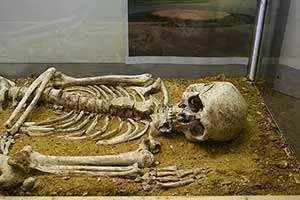Celiac.com 06/24/2013 - Researchers don't know much about the genetic history of celiac disease. They know especially little about the age of specific gene sequences that leave people at risk for developing celiac disease.
 A recent case study provides a small bit of information about that question. The information was gathered by a team of researchers looking into the case of a young, first century AD woman, found in the archaeological site of Cosa. The woman's skeleton showed clinical signs of malnutrition, such as short height, osteoporosis, dental enamel hypoplasia and cribra orbitalia, indirect sign of anemia, all strongly suggestive for celiac disease.
A recent case study provides a small bit of information about that question. The information was gathered by a team of researchers looking into the case of a young, first century AD woman, found in the archaeological site of Cosa. The woman's skeleton showed clinical signs of malnutrition, such as short height, osteoporosis, dental enamel hypoplasia and cribra orbitalia, indirect sign of anemia, all strongly suggestive for celiac disease.
Celiac.com Sponsor (A12):
The research team included G. Gasbarrini, O. Rickards, C. Martínez-Labarga, E. Pacciani, F. Chilleri, L. Laterza, G. Marangi, F. Scaldaferri, and A. Gasbarrini. They are affiliated with the Ricerca in Medicina Foundation NGO, Falcone and Borsellino Gallery, in Bologna, Italy.
However, initial inspection of the woman's bones did not provide answers about the genetics that might confirm that these traits were, in fact, associated directly with celiac disease.
To do that, the team needed to examine her human leukocyte antigen (HLA) class II polymorphism. That required extracting DNA from a bone sample and a tooth and genotyping HLA using three HLA-tagging single nucleotide polymorphisms for DQ8, DQ2.2 and DQ2.5, specifically associated to celiac disease.
The results showed that the woman did in fact carry HLA DQ 2.5, the haplotype associated to the highest risk of celiac disease. This is the first time that researcher have documented the presence of a celiac-associated HLA haplotype in an archaeological specimen.
The results show that the genetic markers associated with high risk of celiac disease are at least a couple of thousand years old.
Source:
- Open Original Shared Link





Recommended Comments